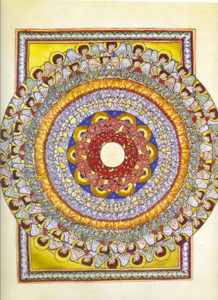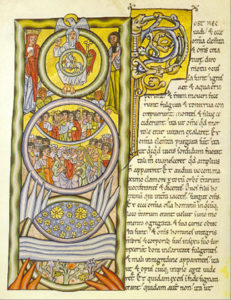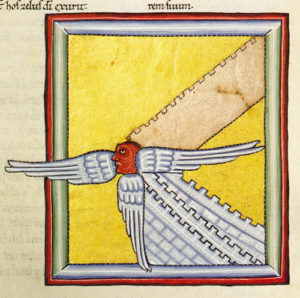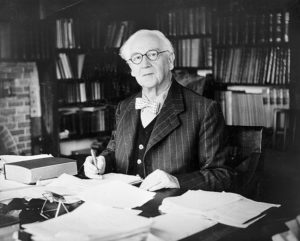By Peter J. Koehler
During the High Middle Ages (1000-1250 CE), the western part of central Europe was reigned as a universum regnum or Romanum imperium, terms that were replaced later by the Holy Roman Empire (a term used from the 13th century). The political unification of the empire was not like that of France. In fact, the empire consisted of many smaller units (kingdoms, duchies, prince-bishoprics, etc.) and the power of the emperor was limited. The regional rulers, although officially vassals of the emperor, were quite independent. Population and urbanization increased, and the economy was growing. The Black Death (starting in this region around 1347) had not yet decimated the number of inhabitants.
Medical Knowledge
Medical knowledge, mainly based upon the ancient Greek books (the Hippocrates corpus, Galen) that were copied in the scriptorium (writing room), had been passed on by medieval monasteries, in particular of the Benedictine order, since the late sixth century.
Handbooks of medical botany from local gardens also played an important role in the monastic infirmaries. Furthermore, medicine was taught in early urban centers including Ravenna and Bordeaux. In the late ninth century cathedral schools like those in Reims and Chartres offered medical instruction. Salerno, at first an important center for practical medicine (10th century), became a famous center for medical theory in the 11th century. Here the works of Arabic medical authors (including Avicenna (980-1037) and Averroes (1126-1198)), who had previously incorporated Hippocratic, Aristotelean, and Galenic works into their medical corpus, were translated. Autopsies were not done at these schools.
A Benedictine Monastery in Northwestern Europe
In the northwestern part of the Holy Roman Empire, in a newly founded monastery (1150) near the estuary of the Nahe (or Nohe) river into the Rhine, east of Mainz, nuns were singing liturgical songs in a monophonic way (one melodic line). See Figure 2. The texts had been written and the music composed by the abbess founder, an extraordinary woman, who had entered the Benedictine monastery of nearby Disibodenberg at the age of eight (1206). She became magistra in 1136. She experienced visual disturbances from age 3 that, years later, she interpreted as sacred visions. She called it umbra viventis lucis, or reflection of the living light.
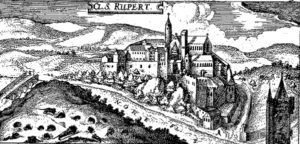
Figure 2. Convent of Rupertsberg near the estuary of the Nahe (or Nohe) river into the Rhine at the time of the 30 Years War (1618-1648).
In her correspondence, at age 77, to Guibert of Gembloux (1124-1213), a monk who became her secretary in 1177, she wrote, “In this vision, my soul, as God would have it, rises up high into the vault of heaven and into the changing sky and spreads itself out among different peoples, although they are far away from me in distant lands and places.” She further explained that “I do not hear them with my outward ears, nor do I perceive them by the thoughts of my own heart or by any combination of my five senses, but in my soul alone, while my outward eyes are open.”
She saw the images while awake, day and night. She was “constantly fettered by sickness” that seemed to be present constantly, resulting in fatigue when “writing the words and visions are there revealed to me.”
Furthermore, she noted that “the grip of pain [could be] so intense that it threatens to kill me.” She did not write where the pain was felt. She saw a light that was “far, far brighter than a cloud which carries the sun.” At a certain moment, she started recording her experiences.
“… the words in this vision are not like words uttered by the mouth of man, but like a shimmering flame, or a cloud floating in a clear sky.”
In 1148, she obtained permission from the pope – it was not without danger to assert that one had been chosen by God – and completed the book with the divine revelations, titled Scivias (Know the Ways) in 1151. It made her famous as a visionary, preacher, and reformer.
Most readers will have recognized the story of Hildegard von Bingen (1098-1179). The manuscript was written at the St. Rupertsberg Monastery before her death (1179) and illuminated by beautiful miniatures that can be seen at the website of the St. Hildegards monastery. The book was destroyed in 1945, but a copy was made between 1927 and 1933.
A Medical Historian
Almost seven centuries later, a historian of science, Charles Singer (1876-1960), who was married to a medieval historian Dorothy Waley Cohen (1882-1964) and studying a subject on contagion, came across one of the books that had been written by the abbess including Scivias, that was still an early version.
He changed the subject of his study, now paying attention to the texts and the crenellated shapes, lights, and fortification figures that characterized the miniatures. He believed to recognize the figures from descriptions of patients during migraine attacks and presented the ideas at a meeting of the Historical Section of the Royal Society of Medicine in London (1913).
In 1917, he published a more extensive chapter in his Studies in the History and Method of Science. He believed that the combination of Hildegard’s ill health, the religious visions, and complete recoveries made it probable that she had been suffering from a nervous disorder.
“She was a sufferer from a condition that would nowadays probably be classified as hystero-epilepsy,” which had been a popular diagnosis at least in the late 19th century. He also diagnosed migraine, noting that “the medical reader or the sufferer from migraine will, we think, easily recognize the symptoms of scintillating scotoma.”
Criticism
There is much to be opposed to the diagnosis of migraine. The present diagnosis migraine with aura including the combination of (usually) visional symptoms with headache was only recognized in the late 18th and 19th centuries. Migraine auras had been described much earlier, but were not named as such. In fact, the term aura derived from the area of epileptic symptoms.
Migraine headache, of course, had already been described by the ancients (Aretaeus, who named it heterocrania and Galen, who changed it into hemicrania). Hildegard described her pain, but did not mention headache in particular. Moreover, the visions she described were too detailed for migraine auras. Furthermore, next to her religious works (Scivias, Liber vitae meritorum and Liber divinorum operum the latter also containing descriptions of vision 4 that included anatomy and physiology), she wrote two books on medical subjects, notably Physica (Liber Simplicis Medicinae; Book of Simple Medicine, which is an inventory of natural therapies) and Causae et Curae (Liber Compositae Medicinae; Book of Compound Medicine; Causes and Cures).
In the latter book, we find a section on migraine, so, if she would have suffered from migrainous headache, one would expect that she would have recognized this. However, we now know that not everyone suffering from migraine with aura, suffers from headache, in particular if it occurs at older age. Furthermore, visions like those described by Hildegard were not rare.
“I saw a great star most splendid and beautiful, and with it an exceeding multitude of falling sparks which with the star followed southward. And they examined Him upon His throne almost as something hostile, and turning from Him, they sought rather the north. And suddenly they were all annihilated, being turned into black coals . . . and cast into the abyss that I could see them no more”
Singer’s idea of migraine as a diagnosis for Hildegard was later adopted by Oliver Sachs (1933-2015) in his book Migraine (1970), noting that they were “indisputably migrainous,” further contributing to the present belief that she did suffer from migraine auras.
“Emigranea” in Causae et Curae
Comparing the writing style of the various works by Hildegard, Singer provided arguments that Causae et Curae may not have been written by her. Gertrude M. Engbring (1896-1985), however, author of Saint Hildegard, Twelfth Century Physician (1940), believed “Her medical writings were … compilations of traditional monastic observations and formulas, enlarged by her own studies and practice.”
The book contains several subjects of neurological interest. As written above, she distinguished “dolore capitis” (pain of the head) from “emigranea,” derived from the Galenic “hemicrania,” and wrote about the comorbidity of migraine and melancholy. She opined that migraine derived from black bile and all bad humours. It only concerns one side of the head, either the right or the left side. If the humours are present in superfluous quantity, it is localized in the right side; if black bile gains the upper hand, it is on the left side.
She suggested an original explanation for the unilaterality of migraine, noting that nobody could survive this cruel pain if it would be located on both sides of the head. At the time, it was thought that the ascending vapours, because of the falx cerebri, went to either the left or the right hemisphere. She wrote that it was not easy to treat this pain. She advised topical application of a mixture of myrrh and aloe with poppy-oil on the head.
De Vertigine and Amentia
Dizziness or vertigo was believed to be caused by too many thoughts without “the leading influence” of the will. The humours rush or, in the contrary, go on “sluggishly without proper order.” If these humours come all together so that they rage in the head all in a mess, they deprive the person of understanding (amentia), like a ship that capsizes in a storm and breaks into two parts.
Many may think that the person is possessed by demons, but that is not the case. The brain is influenced by good and bad humours that are present in the body and therefore soft and moist. When it will be dry, it becomes ill within a short time. Hildegard localized the soul in the heart (like Aristoteles), but the power of the thoughts ascend to the brain.
Falling Evil
With respect to epilepsy, she wrote that “The humours in man are distributed in just measure. But when they affect the veins of the liver his humidity is decreased and also the humidity of the chest is attenuated; so that thus dried, he falls into disease of such a nature that the phlegm is dry and toxic and ascends to the brain. There it produces headache and pain in the eyes and wasting of the marrow, and thus if the moon is in default, he may develop the falling evil [epilepsy]” (from Liber divinorum operum simplicis hominis cols. 789-91; in Migne, 1855; transl. by Singer, 1917).
In general, the humoral (patho)physiological ideas at the time were quite primitive. Hildegard, for instance, wrote on the purification of the brain by its windows, mentioning the eyes, ears, nose, and mouth. Cold and moist excess from the brain is gathered in nose and throat. Singer opined that the influence of the Salernitan school (see above) may be discerned in several of her scientific ideas. The Regimen Sanitatis of Salerno (a domestic medical practice in the form of a poem), written about 1101, was rapidly diffused throughout Europe, and must have reached the Rhineland.
Concluding Remarks
Retrospective diagnoses are always hazardous, in particular if the person lived 1,000 years ago, and one cannot be certain whether Hildegard’s visions were caused by, what today we would call, migrainous auras. Some of the illuminations, in particular those with stars and zigzags, and descriptions indeed resemble auras. Many other illuminations, however, do not depict such figures. Publications, in which the author, like Singer, tried to demonstrate the migrainous nature of the phenomenon, usually only show those illuminations that support their view and omit the others.
Whatever it may have been, while the convent of Rupertsberg was destroyed during the 30 Years War (1632) and discussions on the origin of the visions will go on, the illuminations remain beautiful and the music angelic … (Hildegard von Bingen – Voices of Angels – Voices of Ascension – YouTube). •
